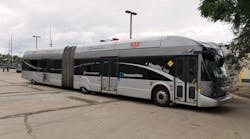Most any government fleet knows what it’s like to face funding challenges, including those not of its own doing. That’s currently the case for the Greater Cleveland Regional Transit Authority (GCRTA), as state funding shortfalls—mainly due to a loss of revenue from a Medicaid tax the federal government disallowed and dwindling support from Ohio general funds—have left GCRTA having to make up the difference.
When that’s the situation the fleet is facing, it’s not a good time to have to pivot suddenly and try to rush solutions. So it’s a good thing GCRTA has been working for years to plan out and put in place an advanced predictive maintenance program for its bus fleets that’s been boosting the vehicles’ reliability and, as a result, better serving customers.
Containing costs meant fleet buses have had to remain in service longer—a continuing need to “do less with more.” But that was a double-edged sword: Costs to keep buses running were high. Fleet-wide in mid-2014, the organization was averaging about 5,000 miles for “miles between service interruption,” or MBSI, a mechanical breakdown measurement for the vehicles. GCRTA began something new to change that in June of 2015.
Exploring what could be done to improve vehicle reliability, GCRTA found that predictive maintenance had helped other cities increase that MBSI measure significantly and cut down on maintenance costs, which also means buses are out collecting fare revenue rather than sitting in the shop. GCRTA worked with a transit asset maintenance company to design its own predictive maintenance program piece by piece, examining the specific breakdowns its bus fleets of various ages experienced.
The result was individualized predictive maintenance programs—complete with parts “kits” set up like clockwork to address specific mechanical failures—that also include traditional preventive and corrective maintenance for the bus fleets. One such fleet of six-year-old GCRTA buses was averaging just 2,800 miles between service interruptions, and 18 months after the predictive maintenance program was initiated, that figure rose to 6,800 miles.
That particular bus fleet also saw a reduction of 12% in repairs due to unexpected breakdowns. GCRTA found the predictive maintenance programs helped manage parts inventory much better. For the first time in more than a decade, the organization closed out 2016 with a positive balance in its inventory department’s operating budget.
“I do think the program will continue to show positive results as we expand to other bus fleets,” GCRTA’s Dan Dietrich, manager of fleet engineering and quality assurance, told Fleet Owner. “Any new fleet we put into service is in the predictive maintenance program from the start, but our older fleets are the ones we are expanding to.
“We have also implemented a quality assurance program to audit our predictive maintenance tasks after they are complete,” he added. “This program will ensure that all the parts are installed correctly and completely.”
At the same time, GCRTA has continued to look for ways to serve its communities and those who rely on it for transportation. In January, GCRTA provided free rides to shelters for the homeless.
Anyone can succeed when the going is easy. Showing foresight and diligence in implementing an advanced predictive maintenance program many government fleets would envy, staying the course even in the face of adversity, GCRTA is doing a great service to the taxpayers and people who depend on its services every day. And it’s Fleet Owner’s pick for Government Fleet of the Year.



